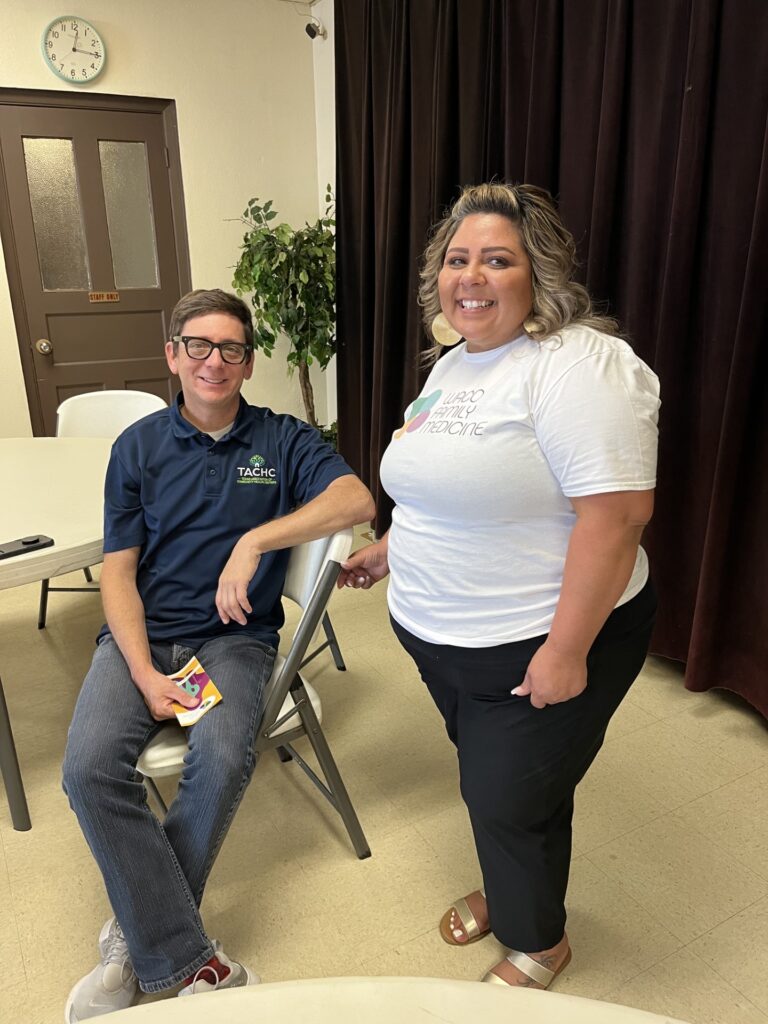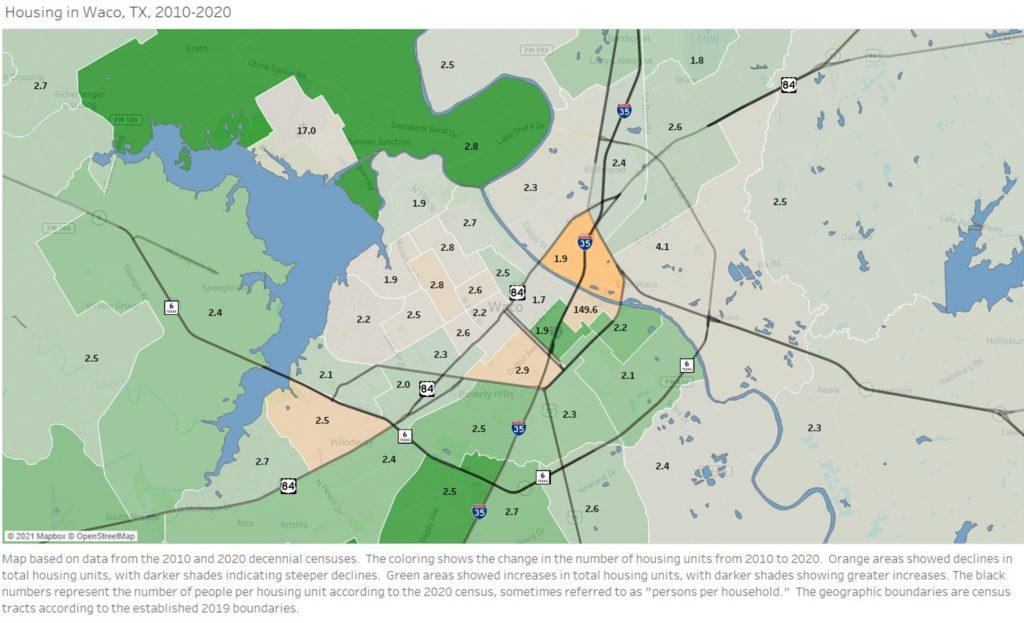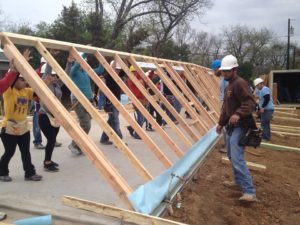On Monday afternoon, Waco Family Medicine (WFM) hosted “Flavor Feast,” a free lunch at the Meyer Center for community members experiencing homelessness. The event included a meal provided by Part Time Chef and a cooling station for attendees.

The event kicked off WFM’s recognition of National Health Center Week (NHCW). NHCW is an annual observance sponsored by the National Association of Community Health Centers (NACHC) running from Aug. 6 to 12. It aims to raise awareness and honor the contributions of Community Health Centers (CHCs) like WFM that provide comprehensive healthcare services to millions of patients across the U.S.
WFM’s NHCW programming includes People Experiencing Homelessness Day (Monday), Patient Appreciation Day (Wednesday), and Health Center Staff Appreciation Day (Friday). Patients and staff will be recognized with tokens of appreciation later in the week.
Each year for NHCW, WFM hosts Healthcare for People Experiencing Homelessness Day to highlight and expand the care provided to community members experiencing homelessness in Central Texas. People who experience homelessness endure higher rates of chronic and acute disease, behavioral health conditions, and other needs that are connected to poorer health outcomes, disability, and early death. Located downtown in the same building as Mission Waco’s Meyer Center, Waco Family Medicine – Meyer Center treats more patients experiencing homelessness than most other locations in the clinic system.


In 2022, WFM provided more than 61,000 patients with integrated medical, dental, and behavioral health care across 15 clinical sites. WFM addresses social and environmental barriers to wellness through innovative programs and community partnerships. Additionally, an in-house pharmacy provides quickly filled prescriptions to patients at a fraction of traditional costs.
With a quarter-million patient visits annually, the WFM system cares for one-fifth of McLennan County’s population. Ninety percent of county residents live within 10 miles of a WFM location, making care more accessible to patients, especially those with limited transportation. In 2021, about 74% of WFM patients identified as a racial or ethnic minority, and 22% were best served in a language other than English. The organization strives to provide high-quality, equitable care to meet the medical needs of Central Texans.
WFM invites community members, partners, and supporters to follow the organization on Facebook and Instagram (@wacofamilymedicine) to learn more about the social and economic contributions of CHCs throughout NHCW.
###
Waco Family Medicine is a Federally Qualified Health Center providing medical, dental, behavioral health, and community health care at 15 locations across McLennan and Bell counties. The nonprofit also provides graduate medical education through Waco Family Medicine – Institute and serves as a clinical training site for medical residency students, dental students, physician assistants, nurse practitioners, clinical social workers, pharmacy students, medical technicians, and allied health caregivers. WFM was established in 1970 to address a shortage of doctors, lack of access to primary healthcare, and economic development issues.
As much of Texas braces itself for several days of sub-freezing temperatures, the Salvation Army in Waco is working to help those experiencing homelessness and provide a warm, safe place to get out of the cold, not just at night, but during the day, too.
The Salvation Army shelter is at 300 Webster Ave. in downtown Waco. It provides overnight shelter for men, women, and families all year round. “On freezing cold days like this week we make arrangements for our building to be open and available during the day as a warming station so that people can come in off the streets and get warm,” said Major James Taylor of the Waco Salvation Army. “They don’t need to register to stay the night and there is no charge for any services at The Salvation Army. We just want those in need to be safe during this cold snap and for them to know that The Salvation Army is here for them.”
Salvation Army also makes plans to accommodate additional overnight guests when the weather is particularly cold. “It is inevitable that more people will come to us for assistance this week, especially seeking overnight shelter from the bitter cold,” said Taylor. “We make emergency beds available in our shelter during inclement weather, in addition to the beds available year-round, and will do our best to make sure everyone has a warm place to sleep. We currently have several people staying in our shelters, including men, women, and families.”
The annual Red Kettle Campaign ends on Christmas Eve and Salvation Army officers, staff, and volunteers are working hard to raise essential funds that make basic services including shelter, meals, and emergency financial assistance possible all year round here in Waco. “The practical, financial support of our community makes it possible for us to help those in need every day of the year, not just at Christmas,” said Major Taylor. “Your support means that The Salvation Army is there to keep the lights on for a family struggling to pay the bills, we can provide a hot meal and cup of coffee to a first responder working during times of disaster, and we can provide a warm, safe place for someone experiencing homelessness when temperatures drop below freezing.”
To make a donation, or for more information about the warming station and inclement weather shelter, please call Salvation Army at 254-756-7271, visit the online at Waco Corps (salvationarmy.org), or stop by at 4271 W. Waco Dr.
By Jeremy Rhodes
The first wave of data releases from the 2020 US Census is here, and many of the demographic shifts that we’ve seen across the country and the state are mirrored in our Waco community. In this series of posts, I am presenting some of the demographic changes we see in McLennan County from 2010 to 2020.
The first post presented numbers regarding general population growth and decline. The second post showed an overview of racial and ethnic changes in the county. The third post expanded on the racial/ethnic changes in McLennan County since 2010. In this post, we will look at some of the changes to the housing landscape in Waco since 2010.
This first map shows the number of housing units in each area, as well as the change in housing units since 2010. The orange areas saw a decline in total housing units, with darker shades indicating a larger decline. The green areas saw an increase in total housing units, with darker shades indicating a larger increase. The top number shows the total number of housing units in that area, while the bottom number shows the change in number of housing units since 2010.
Most of central Waco and north Waco saw little change in total number of housing units from 2010 to 2020. The largest growth in housing units was seen in China Spring, with an addition of 1131 housing units, and Hewitt, with an addition of 1,000 units. Only six census tracts saw declines in the number of housing units since 2010. One of the historic East Waco tracts (tract 15) saw the largest decline in housing units, with a loss of 141 households. Most of the county saw moderate to robust housing growth.

The second map is similar to the first. The coloring is the same, with green shades indicating growth in housing units since 2010, and orange shades indicating decline in housing units since 2010. The black number in each tract is different in this map; it displays the number of residents per household in that area. Most of the county has between two and three people per household. Notable exceptions include downtown Waco and historic East Waco, where there are fewer than two residents per housing unit.
There are two outlier tracts that should be explained. In the northwest of the map, you will see a tract with 17 people per household. That tract is the airport, and we should not think too much about housing and population data for that tract. The other outlier is the tract containing Baylor University, which has a “persons per household” of 149.6. Although the Census Bureau does not consider dorms to be housing units, I cannot be certain how they obtained such a high number while excluding dorms from consideration.

If you have any questions about this, or if you would like Jeremy to give an overview of these changes to your group, staff, or organization through Zoom or in person, please contact Jeremy Rhodes at [email protected].
Jeremy Rhodes, Ph.D., is director of research and community impact for Prosper Waco.
The Act Locally Waco blog publishes posts with a connection to these aspirations for Waco. If you are interested in writing for the Act Locally Waco Blog, please email Ferrell Foster at [email protected].

By Jeremy Rhodes
My family and I are trying to buy a house here in Waco. In case you haven’t heard, that’s hard to do right now. Luckily, we have some generous friends who are allowing us to crash at their place for a few weeks while we get things ironed out.
We have made an offer on seven houses. (I think?… My wife would know for sure.) For at least two of the houses, we know we were the highest bid, but we lost out to some cash offers.
The recent decision of our city council to limit short-term rentals should help the supply of housing for sale, but the impact of that change might not be felt for a while. For now, we are left at the mercy of sellers who we can only hope will see some value in our offers and take mercy on a family trying to finance their home.
Increasing home prices can have ripple effects on rental prices, as well. As my wife and I consider the possibility that we may have to rent for a few months and try to ride out this real estate wave, we are realizing that the cost of renting is rising along with the cost of buying. In some cases, the cost of renting is as high as the cost of a mortgage, but without the benefit of building equity on an asset.
I imagine this squeeze is being felt especially hard for first-time home buyers, especially those who are looking for low-cost homes to buy. About once or twice a week, I hear rumors of West-Coast investors paying cash to snatch up homes to flip, but I’m not sure how or whether those rumors can be verified. The current difficulty of our housing market has more to do with the current low supply of homes for sale than with a surplus of potential buyers.
So please sell me your house, but only if it’s a house I’ll like. We’re not currently in the market for houses we don’t like.

Jeremy Rhodes is director of research and community impact for Prosper Waco.
The Act Locally Waco blog publishes posts with a connection to these aspirations for Waco. If you are interested in writing for the Act Locally Waco Blog, please email Ferrell Foster at [email protected].
By Jimmy Dorrell
With the previously rumored and publicly unannounced closing of the Oak Lodge Motel, based on a desire “to make our city better,” those who live on the edges are about to lose even more access to affordable housing and will likely move into worse conditions. While I realize it is hard to defend this old, challenging motel complex (and other substandard hotels) due to its history, petty drugs, and crime, at this time in Waco there are almost no other choices for housing for hundreds of these “invisible homeless,” including some families with children. Some of those tenants are members of Church Under the Bridge, who attend weekly.

I know our city leaders and some community members care about the poor and may even acknowledge the growing lack of affordable housing in Waco for them. The lack of living wages at work in Waco contributes to their inability to rent housing. Most likely these discussions will not produce any viable answers for years that address the current and growing glut of options for Waco’s most vulnerable.
It is a crisis, not just a problem. It will only get worse for them in the months ahead.
While Church Under the Bridge has recently initiated a new ministry to focus more on that very population, we also have few housing resources to help. Our first ministry goal is to build deeper relationships with the families and individuals and walk with them through their current plight, yet we are realistic to know there are fewer resources that really address the bigger issues of housing them in Waco. It is a community problem that demands increased attention and even interim answers.
I challenge the churches and caring community to make every effort at your disposal to save these and create new housing options before they are evicted onto our streets. I also encourage you to discourage the removal of these who will be displaced until each of them has adequate housing.
Mohandas Gandhi said, “The greatness of a nation can be judged by how it treats its weakest members.” That goes for cities, as well.
We commit to pray for our leaders and local churches as you struggle with these challenging issues and for the poor!
Here are some articles that may help highlight the challenge in our community:
“The People Staying and Living In America’s Hotels” https://www.newyorker.com/culture/photo-booth/the-people-staying-and-living-in-americas-motels
“America’s Hidden Homeless”: https://www.aljazeera.com/features/2016/7/30/americas-hidden-homeless-life-in-the-starlight-motel

Jimmy Dorrell is pastor of Church Under the Bridge in Waco and founder of Mission Waco.
The Act Locally Waco blog publishes posts with a connection to these aspirations for Waco. If you are interested in writing for the Act Locally Waco Blog, please email Ferrell Foster at [email protected].
Editor: In honor of Women’s History Month, we are featuring interviews with local women leaders. These pieces were written by Baylor University students from the Department of Journalism, Public Relations, and New Media.
By Arden Huston
There are people in Waco who need a little more love, understanding, and compassion. It’s time we not only feel their pain but also be moved to help relieve it. We need to give the homeless a little more compassion.

Compassion Waco is working to do that. Compassion is a transitional housing facility for homeless families with children where families can stay up to six months or a year until they learn effective ways to live on their own.
“I don’t know that I had a passion for Compassion when I came, because my image of the homeless was the guy on the street corner who needs a bath and a shave. But I now understand who we serve here is not necessarily that demographic,” Jill McCall, executive director of Compassion Waco, said.
Compassion Waco focuses on serving a specific demographic, which includes families and children. McCall mentioned how it’s important to consider the average age of the homeless in the United States today is 11 and 57% of the homeless are women and children.
“There certainly are those guys on the end of the street corner, but they’re not the majority of the homeless, and they’re not the homeless we serve here in Waco” at Compassion, McCall said.
McCall also shared that her father died when she was 4 and her mother had three kids to take care of. At the time, her mother was lucky enough to have the support of an extended family that was able to assist her emotionally and financially.
Then one day it hit her. “I could have been a child of Compassion, had my mother not had those things and had there been a Compassion, because there wasn’t one then,” McCall said.
When you put things into perspective in this way it’s easier to sympathize with the homeless. The reason many people become homeless is because of a lack of support and financial understanding.
“I think we all can agree most of us get out of high school or college and most of the time we haven’t been very accountable with our money. I mean we’ve never been made to be,” McCall said.
This is a common reason for homelessness. People that come to Compassion often haven’t had anyone to teach them how to budget their money, and they come to learn just that.
“People have to want the help; they have to be at that point in their lives where they’re ready to accept that help. Sometimes people are too proud to accept it,” McCall said.
Compassion has a variety of volunteer opportunities for people who want to help, especially those who like working with kids. They are always in need of people to provide after school care and monitor the children in the computer room.
McCall mentioned a challenge of the job is not being able to see the people while they’re on the other side of things, when they’ve gotten their lives together and aren’t in need of help anymore.
She cites a popular proverb of uncertain origin. “We are planting trees knowing full well, we will never see the shade,” McCall said. “That, on the other hand, says the shade will come. We may not see it, but that’s not what’s important. What’s important is that they find the shade.”

Arden Huston is a sophomore at Baylor University from Houston double majoring in psychology and professional writing.
The Act Locally Waco blog publishes posts with a connection to these aspirations for Waco. If you are interested in writing for the Act Locally Waco Blog, please email Ferrell Foster at [email protected].
by Phil York, Act Locally Waco Housing and Homelessness Policy blogger
Since the post-holiday season, we have used the motif of unwrapping gifts to understand some of the dimensions of housing and homelessness.
We started our discussion with a definition of homelessness through Housing and Urban Development (the federal agency that administers national housing programs). We then discussed how this definition is applied to children, veterans and our other neighbors who may not have a home.
The purpose of our conversation is to keep us all informed: we need to be aware of how decisions made in Washington affect our lives in Waco.
We can use the lessons learned over the past few months and apply them to the latest update from Washington. Let us use our knowledge-base to unwrap:
- The basics of the proposed legislation
- Possible local implications of the proposed legislation
- Ways we can continue our collective efforts to build a stronger Waco
The Basics of the Proposed Legislation:
The U.S. House of Representatives Fiscal Year 2015 Transportation, Housing and Urban Development (THUD) bill is scheduled for House Appropriations Mark-up next week.
Here are the basics about the bill (a paraphrased summary provided by CSH – A Housing Policy and Advocacy Group (www.csh.org )):
- Overall, the House version of the FY2015 THUD Appropriations bill would decrease funding for HUD by $769 million from the FY2014 levels.
- The bill flat funds the Homelessness Assistance Grant programs, providing $2.1 billion. It did not accept the $300 million increase proposed by President Obama.
- There is a slight increase in Housing Choice Voucher program; however, the funding provided does not restore the 40,000 vouchers that were lost to sequestration.
- Funding for the HOME program cut by $300 million.
The U.S. House of Representatives Committee reports specifically about the Community Planning and Development program with the following update in a May press release:
“The bill contains $6.2 billion for Community Planning and Development programs – a reduction of $383 million below the fiscal year 2014 enacted level. The Community Development Block Grant formula program is funded at $3 billion – effectively equal to last year’s level – while the HOME Investment Partnerships Program is funded at $700 million, a reduction of $300 million below the fiscal year 2014 enacted level.
Subcommittee Chairman Tom Latham provided the following commentary about the proposed bill:
“My priorities in this process were to act in a bipartisan fashion to fund our most vital programs with our critical need to reduce the deficit. This is a sound, commonsense bill that meets our highest transportation and housing priorities in a fiscally responsible way. I look forward to working with my colleagues on both sides of the aisle to move this important legislation forward in an open legislative process.”
Possible Local Implications of the Proposed Legislation:
 Waco Habitat is just one of many organizations that partner with the City of Waco to build a stronger Waco with the programs described above. Here are a few ways Waco Habitat used these precious public dollars to improve our community:
Waco Habitat is just one of many organizations that partner with the City of Waco to build a stronger Waco with the programs described above. Here are a few ways Waco Habitat used these precious public dollars to improve our community:
ReStore:
- By using Community Development Block Grant (CDBG) funds through a zero percent loan (that was paid back within three years), the Waco economy has been greatly impacted for the good.
- ReStore offers affordable building materials to people in our community, recycles products thus diverting them from the landfill, and supports administrative efforts of our organization.
- ReStore diverts 3,000 tons from the landfill annually and saves the city about $164,000. The net income from ReStore assures donors to Waco Habitat that 100% of their gift goes to build and repair homes in our community.
New Home Construction Program:
- We are concerned that funding levels proposed in the FY 2015 House THUD bill will make it more difficult for us to serve people living at 30% to 60% area median family income.
- Without HOME funds our partnership housing ministry would be greatly thwarted. Since 1999, Waco Habitat for Humanity has served as a Community Housing Development Organization.
- With over $3.1 million, we have built 48 houses.
- Home ownership assures about seven new home owners join the tax paying roles each year.
- Home ownership adds to the tax base of our community, improves schools, enhances professional opportunities, strengthens school performance, expands likelihood of graduation, and spreads hope for future generations.
Habitat achieved the above accomplishments thanks to our public fund partnerships. Budget cuts today affect Waco’s ability to realize a community where everyone has a decent place to live.
Ways We Can Continue Our Collective Efforts to Build a Stronger Waco:
- Remain informed: The most important call to action is for us to remain informed about the current policy landscape. Regardless of your political background or interest, we share common ground in the preservation and long term health of Waco. Follow the work of the US Committee on Appropriations: http://appropriations.house.gov/news/.
- Have your voice heard: Contact your U.S. House representative. Please provide your Representative with the talking points provided above. If your Representative is Mr. Bill Flores, you have the convenience to contact Rep Bill Flores directly via email (https://billflores.house.gov/contact/ ).
- Connect directly to the mission: There are volunteer opportunities at Habitat and other nonprofit organizations that work directly with our neighbors in need. These organizations offer opportunities for you to give of your time and talent.
Your donations, whether they be of time or money, are important – they bind us together. Once connected, we may share the urgency of the above implications and collectively move our leadership to join us as we build a stronger Waco together.
 Phil York, Director of Development at Waco Habitat for Humanity, is a self-described “policy nerd;” he is also the Act Locally Waco housing and homelessness policy blogger. You can direct questions to Phil to [email protected]. Would you be interested in blogging for Act Locally Waco? If so please email [email protected].
Phil York, Director of Development at Waco Habitat for Humanity, is a self-described “policy nerd;” he is also the Act Locally Waco housing and homelessness policy blogger. You can direct questions to Phil to [email protected]. Would you be interested in blogging for Act Locally Waco? If so please email [email protected].
by Phil York, Act Locally Waco Housing and Homelessness Policy blogger
“It is simply unacceptable for individuals, children, families and our nation’s Veterans to be faced with homelessness in this country” – President Obama, June 18, 2009.
Who is your favorite superhero?
It seems like the silver screen is flush with superhero smash hits every summer. Batman, with his man cave and great car, is my second favorite superhero. But before I was acquainted with Warner Brothers and Marvel Comics, my first favorite superhero was (and continues to be) my Father. Like all other superheroes, my Dad wore a superhero suit (his uniform), and in my eyes, saved the world each day during his career in the United States Navy.
In my previous posts we have discussed the broad implications of homelessness and how homelessness affects our community, our economy and our youth. Today we will unwrap a basic understanding of homelessness among Veterans: Our American Heroes.
National Policy
The Obama Administration publically calls housing a basic human right. The flagship federal agency for housing initiatives, policy, and public funding related to housing is Housing and Urban Development (HUD). Under the leadership of Secretary Shaun Donovan, HUD and many other agencies partner so we can do more about homelessness through a holistic approach. That collaborative group is called The United States Interagency Council on Homelessness (USICH). It is an independent agency comprised of 19 Cabinet Secretaries and agency heads that coordinate responses to homelessness. HUD, USDA, Department of Veteran Affairs, Social Security Administration, and Department of Homeland Security are just a few of the partner agencies involved.
This interagency collaboration is mandated by The Hearth Act (signed into law by President Obama May 2009). President Obama’s Opening Doors Plan (drafted in 2010), is the United States’ first comprehensive strategy to prevent and end homelessness. The Plan is focused on four key goals: (1) Finish the job of ending chronic homelessness in five years; (2) Prevent and end homelessness among Veterans in five years; (3) Prevent and end homelessness for families, youth, and children in ten years; and (4) Set a path to ending all types of homelessness. USICH uses this plan to guide program implementation.
How are we doing?
Here is a timeline of the progress that has been reported regarding homeless Veterans:
2009 – According to President Obama’s plan document (p. 20), in 2009, the VA estimated 107,000 homeless Veterans on any given night.
2010 – According to Green Doors, a central Texas nonprofit corporation and a Veteran advocacy group, the Department of Veteran Affairs (VA) estimated that on any given night there were 76,000 homeless veterans sleeping on American streets.
2011 – On December 13, 2011, HUD released the 2011 Point-In-Time Count Report that showed there were 67,495 homeless veterans in the United States (including sheltered and unsheltered). Among those reported were 1,500 in Texas, and 40 in Waco/McLennan County.
2012 – According to Housing and Urban Development’s Point-in-Time Survey, January 2012, 62,619 veterans were homeless on a single night in January 2012. Texas had by far the largest number of homeless veterans among statewide counts with 1,481 homeless veterans on a single night.
2013 – HUD’s “2013 Continuum of Care Homeless Assistance Programs Homeless Populations and Subpopulations Report” states the count of homeless veterans (sheltered and unsheltered) as 58,063. According to a blog post by Secretary Donovan on December 2013, “The numbers since 2010 when Opening Doors was created are encouraging… homelessness among Veterans fell an incredible 24 percent.” He credits this improvement to the strong working partnership between HUD and Veterans’ Affairs and to a commitment to learning from evidence-based research.
A lot left to Un-Wrap
The most common metric in homelessness policy is the Point-In-Time Count. Most communities conduct a Point-In-Time count once a year, usually in January. It counts people who are unsheltered or in emergency shelters or transitional housing. Families, youth, and other individuals who are doubled up are not included. The Point-in-Time Count may be the best we can do as far as measuring homelessness, but it is far from perfect.
When I served as a Point-In-Time surveyor in Brazos County, “are you a Veteran?” was a question on the verbal survey. There are several important things to consider about that question:
- The survey itself is voluntary
- This specific question is a voluntary, self-selected answer
- Depending on its place in the survey order, it may not be asked before the participant elects to end the conversation
- The participant needs to trust the surveyor; without trust little information can be collected.
Given the flaws of the Point-In-Time Survey that several of our sources identify, I am reluctant to share HUD’s rosy estimate of the progress that has been made. I agree that the data from multiple sources supports the conclusion that we have made at least some steps in the right direction; the question remains of how large those steps have been.
I say that not to be pessimistic about our progress, but to make sure we complete the race before we celebrate its end. If data points are used to judge success or failure of our agencies we need to know as informed citizens the nature of that data. The data collection challenge is a reoccurring theme across all topics and demographics of homelessness. It is worth describing in each blog as it affects each group uniquely.
One uniform opinion across data sources is that the true number of homeless veterans is more than likely higher than the estimate. Much work remains to be accomplished with this important population. Considering their sacrifice, our Veterans and their families remain our heroes long after they retire their uniforms. I look forward to our next discussion about this important topic.
 Phil York, Director of Development at Waco Habitat for Humanity, is a self-described “policy nerd;” he is also the Act Locally Waco housing and homelessness policy blogger. You can direct questions to Phil to [email protected]. Would you be interested in blogging for Act Locally Waco? If so please email [email protected].
Phil York, Director of Development at Waco Habitat for Humanity, is a self-described “policy nerd;” he is also the Act Locally Waco housing and homelessness policy blogger. You can direct questions to Phil to [email protected]. Would you be interested in blogging for Act Locally Waco? If so please email [email protected].
by Phil York, Act Locally Waco Housing and Homelessness Policy blogger
The previous months welcomed the annual holiday season. Some of us spent time unwrapping gifts with high anticipation for what would be revealed underneath the glitter and flashy paper. In one of our previous posts we talked about the rise of homelessness among a few specific demographic groups. Today we will start to “unwrap” one of those groups as we learn a bit more about homelessness among children. The Charles A. Dana Center of The University of Texas reports that “over a course of a year, between 2.3 and 3.5 million people will experience homelessness in the United States, of which between 900,000 and 1.4 million will be children.”
Unfortunately, any conversation about homelessness must depend on ranges or estimates. As you might imagine, the very nature of homelessness makes it difficult to accurately count the people who are experiencing that situation. It is particularly challenging to get an accurate count of our homeless children and youth because the federal definition of “homelessness” as it applies to children is quite complex.
Children are considered homeless if they:
- Are abandoned in hospitals.
- Are awaiting foster-care placement.
- Are living in environments not intended for habitation such as cars, parks, motels, public spaces, train stations.
- Are living in substandard housing.
- Are living in transitional housing.
- Are sharing housing of others because of loss of housing, economic hardship.
- Are displaced by a natural disaster.
- Are fleeing a domestic abuse situation.
- Are living temporarily with a relative in another town because a parent is hospitalized for illness or surgery.
- Are immigrant students living in a homeless situation, without regard to whether they are in the US legally or illegally.
As you can see, child homelessness is more difficult to define than it might at first appear. This makes it even more difficult to observe. For example, a third grade student in WISD might technically have a roof over her head for the night, yet still suffer from inadequate housing. She would not be counted in a “point in time” count of those living on the street, but she is still considered homeless by the federal definition. Despite this complicated definition, thanks to the diligent work of the Homeless Outreach Services at WISD and the City of Waco we are able to estimate the number of homeless children in Waco ISD. That number, according to a May 2013 report by KXXV news is right around 1,500.
This definition of child homelessness is codified in a law called the McKinny-Vento Act. This law provides protections to youth that fall under the definition of homelessness and who are 21 and under (or until high school graduation in some states). Each school district is required by law to have a McKinny-Vento specialist available on staff to serve, protect and preserve the rights of homeless students. The specialist’s duties include:
- Identification of homeless children.
- Ensuring that homeless children enroll in and have a fair opportunity to succeed in school.
- Making referrals to health care, dental, mental health and other appropriate services.
- Informing parents and guardians of the educational and related opportunities available to their children and provide them with meaningful opportunities to participate in that education.
- Disseminating public notice of educational rights.
- Informing families and youth about transportation services and assisting them in accessing transportation.
The McKinny-Vento specialist for Waco ISD is Cheryl Pooler. She shared some insights about her work in a 2013 interview with KWBU. In the interview, Ms. Pooler described the difficulty of the first duty of her post: simply identifying students who may be eligible for programs.
National, state and local realities compel policy such as the McKinny-Vento Act which broadens the definition of homelessness among youth. This is important because homelessness is a complex issue that cannot be addressed without definitions and policies that are flexible enough to meet the complexity. But with complexity comes bureaucracy, including the documentation obstacles Ms. Pooler described in her interview.
The McKinny-Vento Act is not a simple piece of legislation. The definition of homelessness for children is not simple. Even the most basic task of figuring out how many homeless children we have in Waco is not simple. Perhaps we should let all of this legal complexity serve to remind us that life as a homeless child is certainly not simple. Consider for a moment how difficult it would be for a child experiencing any of the situations enumerated in the federal definition of homelessness to focus on school work.
“Unwrapping” the challenge of child homelessness is not a simple endeavor. Much more remains to be unwrapped. We will continue to unwrap homelessness, understand its scope and the policies around it in future posts.
 Phil York, Coordinator of Grants and Contracts at Waco Habitat for Humanity is a self-described “policy nerd;” he is also the Act Locally Waco housing and homelessness policy blogger. You can direct questions to Phil to [email protected]. Would you be interested in blogging for Act Locally Waco? If so please email [email protected].
Phil York, Coordinator of Grants and Contracts at Waco Habitat for Humanity is a self-described “policy nerd;” he is also the Act Locally Waco housing and homelessness policy blogger. You can direct questions to Phil to [email protected]. Would you be interested in blogging for Act Locally Waco? If so please email [email protected].


